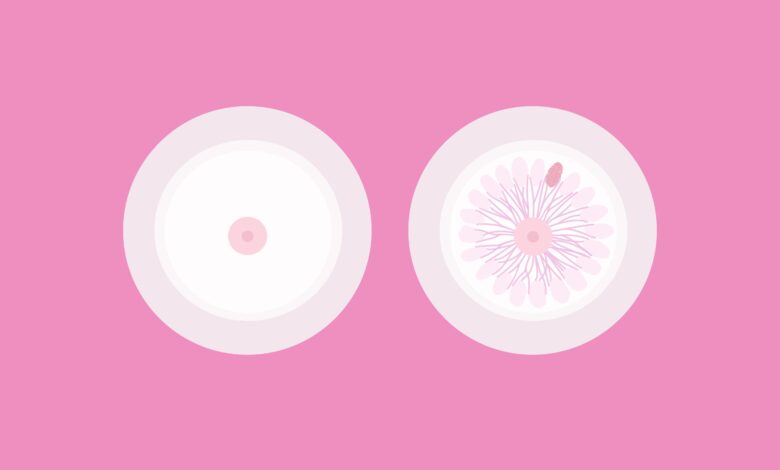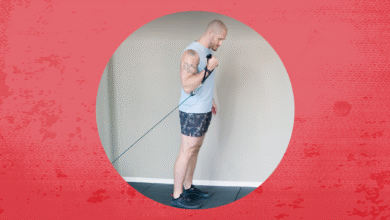Does Breast Cancer Hurt? What You Need to Know About This Less Common Symptom

There are plenty of misconceptions swirling around breast cancer, like people assuming that men can’t get the disease or that wearing a bra can cause it. But one of the biggest and potentially most harmful myths is that breast cancer can’t hurt.
That concept surfaced again late last week, after former Bachelorette star Katie Thurston revealed that she has breast cancer. The 34-year-old shared in an Instagram Story that she noticed she had a lump in her breast, but waited to have it evaluated by a doctor because it was painful. That pain “probably led to more doubt and delay on getting it checked out as most [websites] will say ‘most breast cancers don’t hurt,’” Thurston wrote. “I really thought it was PMS or working out,” she added.
Unfortunately, doctors who treat patients with breast cancer say this is a common misconception—and one that can lead to a delay in diagnosis and treatment. Here’s why and when breast cancer can hurt, plus how to know when you should see a doctor for pain in your breast.
There are multiple reasons why breast cancer could hurt.
To be fair, yes, most women with undiagnosed breast cancer don’t have pain. “It is not common for breast pain to be associated with breast cancer. However, it still can happen,” Nicole Williams, MD, a breast medical oncologist with the Ohio State University Comprehensive Cancer Center – James Cancer Hospital, tells SELF.
But there are a handful of reasons why you might feel pain with breast cancer, and a lot of it boils down to the size of the tumor and where it’s located, Richard J. Bleicher, MD, chief of the division of breast surgery at Fox Chase Cancer Center, tells SELF. “If you have a breast cancer that’s very large, it can impinge on nerve structures, muscle structures, bone structures, and any component of the breast outside of the breast tissue—that can cause pain,” he says.
But even small tumors can lead to pain. “Breast cancers tend to be very hard,” Dr. Bleicher says. “Even if a lesion is small, it will cause discomfort if it is impinging on a nerve or muscle.”
Certain types of breast cancer are also more likely to be uncomfortable than others, Jason Mouabbi, MD, assistant professor in the department of breast medical oncology at the University of Texas MD Anderson Cancer Center, tells SELF. Inflammatory breast cancer, which accounts for up to 5% of all breast cancers, usually causes symptoms like redness, swelling, and a lot of pain in the breast, he points out. “But all breast cancers have the potential to cause pain,” Dr. Mouabbi says.
The myth that breast pain can’t be a sign of cancer is persistent.
The assumption that breast cancer won’t hurt is a “relatively fair one,” Dr. Bleicher says. The majority of the time, breast pain won’t be due to breast cancer, Katherine Cline, CNP, a breast cancer nurse practitioner with the Ohio State University Comprehensive Cancer Center – James Cancer Hospital, tells SELF. There are so many more likely reasons your breasts could hurt. “Breast pain is mostly caused by hormonal changes, certain medications, cysts/benign masses, or infections,” Cline says. Given that breast cancer is also painless more often than not, it’s easy to see how people might write it off completely as a potential explanation for this symptom.
On top of that, considering how serious breast cancer is, many people may also prefer to lean into the idea that breast cancer can’t hurt if they develop pain, to try and give themselves some peace of mind, Dr. Mouabbi says. And since there are a handful of other more likely explanations for breast pain (hello, hormones), it can be easier to just brush it off and assume it’s NBD than to go through the whole process of seeing a doctor and getting checked out.
But despite all of this, many healthcare providers are trying hard to get the right information out there. “This is something that I discuss a lot with my patients,” Dr. Mouabbi says.
There are a few clues you may be dealing with breast cancer pain over “normal” breast pain.
It’s important to state this up front: The only way to know for sure what could be going on inside your breast is to have proper screening done, including an evaluation from a doctor and a scan like a mammogram or breast ultrasound. “The average individual will not be able to tell the difference,” Dr. Bleicher says. “Sometimes it’s even a challenge for providers, just based on characteristics.” Still, there are a few signs that you might be dealing with breast pain related to cancer versus something else.
“If pain is persistent and you can really pinpoint it to one location, that’s important to know,” Dr. Mouabbi says. So is pain that happens alongside nipple discharge, including bloody discharge. “That almost always leads to a mammogram and ultrasound,” Dr. Mouabbi says.
But pain that comes and goes can also be linked with breast cancer. “If the pain waxes and wanes, there is going to have to be a little judgement on the part of the person,” Dr. Bleicher says. “If there’s nothing she feels may have caused this, always err on the side of caution and talk to a provider.”
Ultimately, it’s worth seeing a doctor about any unexplained breast pain.
If you suddenly develop pain in your breast, Dr. Mouabbi says you shouldn’t panic and assume you have breast cancer. “Give it a few days,” Dr. Mouabbi says. “Even the most aggressive types of breast cancer won’t make a difference if you wait that long.”
But if the pain persists beyond that, you have nipple discharge, you find a lump, or you just have no clue what’s going on, it’s time to make an appointment with a healthcare provider. “They would do the proper work-up with a health history, physical exam, and proper imaging to evaluate it,” Dr. Williams says.
Again, it’s more likely than not that your breast pain is due to something else, but you don’t want to write off the possibility of cancer entirely. Getting it checked out will help you know for sure, give you peace of mind, and ultimately make it possible to catch something concerning as early as possible.
Related:
- Are My Nipple Bumps Normal or Something to Worry About?
- What Is a Breast Cancer Risk Assessment Score—And Should I Get One?
- 6 Things All Black Women Need to Know About Breast Cancer
Get more of SELF’s great service journalism delivered right to your inbox.



